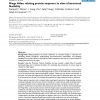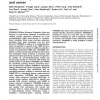148 search results - page 15 / 30 » The evolutionary capacity of protein structures |
BMCBI
2007
13 years 7 months ago
2007
Background: Relating features of protein sequences to structural hinges is important for identifying domain boundaries, understanding structure-function relationships, and designi...
BIBM
2010
IEEE
13 years 5 months ago
2010
IEEE
ATP is a ubiquitous nucleotide that provides energy for cellular activities, catalyzes chemical reactions, and is involved in cellular signaling. The knowledge of the ATPprotein in...
NAR
2010
13 years 2 months ago
2010
PROSESS (PROtein Structure Evaluation Suite and Server) is a web server designed to evaluate and validate protein structures generated by X-ray crystallography, NMR spectroscopy o...
BMCBI
2007
13 years 7 months ago
2007
Background: The rapid burgeoning of available protein data makes the use of clustering within families of proteins increasingly important. The challenge is to identify subfamilies...
BMCBI
2004
13 years 7 months ago
2004
Background: We establish that the occurrence of protein folds among genomes can be accurately described with a Weibull function. Systems which exhibit Weibull character can be int...


